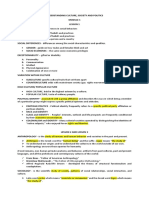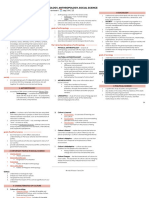Uscp Lesson 1 2 PDF
Uscp Lesson 1 2 PDF
Uploaded by
Jessierhy Mae CanoCopyright:
Available Formats
Uscp Lesson 1 2 PDF
Uscp Lesson 1 2 PDF
Uploaded by
Jessierhy Mae CanoOriginal Description:
Original Title
Copyright
Available Formats
Share this document
Did you find this document useful?
Is this content inappropriate?
Copyright:
Available Formats
Uscp Lesson 1 2 PDF
Uscp Lesson 1 2 PDF
Uploaded by
Jessierhy Mae CanoCopyright:
Available Formats
Discipline of uscp
Social Science Cultural Anthropology
→ studies cultural variations develop across
Social science, any branch of academic different societies and examines the need to
study or science that deals with human understand each culture in its own context.
behavior in its social and cultural aspects.
Usually included within the social sciences Linguistic Anthropology
are cultural (or social) anthropology, → studies language discourse and how they
sociology, psychology, political science, and reflect and shape different aspects of human.
economics. (Greenfeld & Nisbet, 2020)
Biological and Physical Anthropology
The discipline under which identity, culture, → studies origins of humans as well as the
society, and politics are studied. interplay between social factors and process
of human evolution, adaptation, and
Are comprised of a wide array of disciplines variations over time.
that studies the overall function of a
society as well as the interactions among Archaeology
individual members of an institution. → deals with prehistoric societies by studying
their tools and environment.
Anthropology:
the Science of Culture Sociology:
the Science of Society
→ is the scientific and humanistic study of
human beings. It encompasses the → the scientific study of human society
evolutionary history of humanity, physical and social interactions. main goal is to
variation among humans, the study of understand social situations and look for
past societies, and the comparative study repeating patterns in society.
of current-day human societies and
cultures. The main focus of sociology is the group,
not the individual. Sociologists attempt to
Main Goals: understand the forces that operate throughout
society—forces that mold individuals,
o describe, analyze, and explain different shape their behavior, and, thus, determine
cultures, social events.
o show how groups live in different
physical, economic, and social Political Science:
environments the Science of Politics
o show how their members give meaning
to their lives. Political science is an academic discipline that
o attempts to comprehend the entire seeks to study politics scientifically and to
human experience. address empirical (factual) and normative
(ethical) questions about politics.
Main Subfields:
o Why do people vote as they do?
Social Anthropology o Why are some people conservative
– studies how social patterns and practices and others not?
and cultural variations develop across o Does money buy elections?
different societies.
The subject matter of politics is varied and
complex, and political science is no less so.
Main Subfields:
Comparative politics, focusing on
examining how different political systems
operate.
International relations, focusing on
relationships between and among states.
International relations studies what transpires
between states. (Diplomacy and War).
Political research methods, focusing on a
study of the many details of empirical social
science. Data collection, measurement, and
analysis are key areas of inquiry in this
subfield.
Political theory includes the study of the
history of political philosophy, philosophies of
explanation or science, and philosophical
inquiries into the ethical dimensions of politics
Society and culture
Topic Outline Culture:
The basics
o Society
→ Nature of Society → a blueprint for living in a particular society
o Culture → To sociologists, however, every human
→ Components being is cultured. All human beings
→ Elements of culture participate in a culture, whether they are
Harvard educated and upper class or illiterate
CULTURAL IDENTITY and living in a primitive society. Culture is
• Ethnicity crucial to human existence.
• Age → CULTURED VS “UNCULTURED”
• SOGIE
• Religion/spirituality Culture:
• Social class Characteristics
CULTURAL ISSUES 1. CAN BE LEARNED
• Culture shock 2. Can be MATERIAL OR IMMATERIAL
• Cultural lag 3. PATTERNED BEHAVIOR
• Ethnocentrism 4. CAN BE CREATED
• Cultural Relativism 5. SHARED
Society Culture:
Types
→ A society is a system of interrelationships
that connects individuals. MATERIAL CULTURE
→ Latin for the ties that bind people → consists of human technology—all the
together. things human beings make and use, from
→ societas from socius, and the French small, handheld tools to skyscrapers. Even
societé which means companion, chum, more important, humans use material culture
comrade, associate, or partner. to modify and exploit the environment for
survival and stability
Main Characteristics:
NONMATERIAL CULTURE
o Organized → which consists of the totality of knowledge,
o Dynamic beliefs, values, and rules for appropriate
o Likeness behavior. The nonmaterial culture is
o Differences structured by such institutions as the family,
o Interdependence religion, education, economy, and
o Cooperation government.
o Conflict
Culture:
The basics
→ culture is all that human beings learn to
do, produce, know, believe
as they live out their lives in the social groups
to which they belong.
Culture:
Elements
1. Symbols
→ anything that carries a particular meaning
recognized by people who share a culture.
2. Language
→ a system of symbols that allows people to
communicate
→ Through language we can transmit culture.
Wisdom over time is passed down through
language.
3. Norms
→ Are standards and expectations for
behaving.
→ are acceptable and appropriate within a
culture.
→ divided into two types, formal
norms, and informal norms
• Formal norms → important standards
of Behavior
o Mores → norms that are widely
observed and have great moral
significance. ( e.g. taboos Incest,
rape, murder)
o Laws → officially written set of
rules, ratified by the government
• Informal norms → considered less
important but still influence how we
behave.
o Folkways→ norms of routine or
casual interaction (ex. Shaking
hands, eating styles, saying excuse
me)
4. Rituals
→ established procedures and ceremonies
that often mark transitions in the life course.
→ reflect and transmit a culture’s norms and
other elements from one generation to the
next.
5. Values
→ involve judgments of what is good or bad
and desirable or undesirable. A culture’s
values shape its norms.
6. Artifacts
→ or material objects, that constitute a
society’s material culture.
You might also like
- Ucsp 1stqrsem ReviewerDocument5 pagesUcsp 1stqrsem ReviewerNicole BalaNo ratings yet
- Reviewer in UcspDocument7 pagesReviewer in UcspsamthesketchyNo ratings yet
- Chapter 1 FamPlanDocument76 pagesChapter 1 FamPlangalgaddotNo ratings yet
- Starting Points in The Understanding of Culture, Society, and PoliticsDocument26 pagesStarting Points in The Understanding of Culture, Society, and PoliticsWarlito CoronelNo ratings yet
- Grade 11 Module HistoryDocument5 pagesGrade 11 Module HistoryDulce Amor Christi LangreoNo ratings yet
- UCSP Ready Ma-ItlogDocument21 pagesUCSP Ready Ma-ItlogKyron madriagaNo ratings yet
- Concepts Aspects and ChangesDocument3 pagesConcepts Aspects and Changesy4368150No ratings yet
- Understanding Culture, Society, and Politics / Pre-First QuarterDocument5 pagesUnderstanding Culture, Society, and Politics / Pre-First QuarterKim Kathleen ArizaNo ratings yet
- Ucsp M1 6 ReviewerDocument9 pagesUcsp M1 6 ReviewerWayne Kendrick Marañon NeriNo ratings yet
- Ucsp Reviewer Chapter 1-2 in Grade 11Document5 pagesUcsp Reviewer Chapter 1-2 in Grade 11Region Fernandez100% (10)
- UCSP Chapter 1-5 ReviewerDocument8 pagesUCSP Chapter 1-5 ReviewerAndrea Monica100% (1)
- Ucsp Module 101Document60 pagesUcsp Module 101Joshua CorpuzNo ratings yet
- Uscp Notes b5Document3 pagesUscp Notes b5Julia Cristine GalinoNo ratings yet
- Udself Midterm NotesDocument22 pagesUdself Midterm NotesmrnxakeiraNo ratings yet
- Lesson 1: Nature, Goal, and Perspective in Anthropology, SociologyDocument14 pagesLesson 1: Nature, Goal, and Perspective in Anthropology, SociologyIvan TrinidadNo ratings yet
- UCSP-REVIEWER (1)Document6 pagesUCSP-REVIEWER (1)dominiccastillo0909No ratings yet
- UCSP Reviewer Nature, Goals, and Perspective of Anthropology, Sociology, and Political ScienceDocument5 pagesUCSP Reviewer Nature, Goals, and Perspective of Anthropology, Sociology, and Political ScienceYssabelle ViernesNo ratings yet
- Unit 1 Chapter 2 USCPDocument50 pagesUnit 1 Chapter 2 USCPDon LimNo ratings yet
- Format For Dual SideDocument40 pagesFormat For Dual SideUsama TariqNo ratings yet
- Chapter 1 FinalDocument3 pagesChapter 1 FinalAllen Simon BaulaNo ratings yet
- Ucsp 11 (KZ)Document3 pagesUcsp 11 (KZ)meganandkyzlNo ratings yet
- UCSP ReviewerDocument4 pagesUCSP ReviewerChirsten ArabejoNo ratings yet
- UscpDocument2 pagesUscpGalino Julia Cristine A.No ratings yet
- TRADITIONSDocument10 pagesTRADITIONSVanito SwabeNo ratings yet
- 1st Q - Understanding of Culture, Society and Politics ReviewerDocument5 pages1st Q - Understanding of Culture, Society and Politics Reviewerashleymae.cavadaNo ratings yet
- Culture H1Document4 pagesCulture H1Schynly Fritz PidoNo ratings yet
- Lesson 1 Introduction Understanding Culture, Society, and PoliticsDocument67 pagesLesson 1 Introduction Understanding Culture, Society, and PoliticsAlfredo ModestoNo ratings yet
- Review Material, Module 1, AnthropologyDocument5 pagesReview Material, Module 1, AnthropologyRoxanne GongobNo ratings yet
- Sociology, Anthropology & PoliticsDocument38 pagesSociology, Anthropology & PoliticsBenjo EdadesNo ratings yet
- 3rd Quarter REVIEWER RysDocument11 pages3rd Quarter REVIEWER RysKIRSTEN BIANCA REYESNo ratings yet
- Orca Share Media1667799603812 6995258549469788117Document28 pagesOrca Share Media1667799603812 6995258549469788117Michelle AblanNo ratings yet
- Part 1 - N&WDocument20 pagesPart 1 - N&WEspam 682No ratings yet
- The Social Sciences and The Three FacesDocument15 pagesThe Social Sciences and The Three Facesafstw4egNo ratings yet
- UCSP - ReviewerDocument4 pagesUCSP - ReviewerellyznicolecNo ratings yet
- UCSPDocument4 pagesUCSPFrances Lorielyn TaborNo ratings yet
- Unit 3-Anth 1012Document52 pagesUnit 3-Anth 1012km4874430No ratings yet
- Unit Three:: Human Culture and Ties That Connect SocietyDocument52 pagesUnit Three:: Human Culture and Ties That Connect SocietyErmi Zuru100% (1)
- Understanding Culture, Society and Politics: First QuarterDocument12 pagesUnderstanding Culture, Society and Politics: First QuarterLalaine PascualNo ratings yet
- UCSP Chapter 1Document24 pagesUCSP Chapter 1PASCUA, Louisse I.No ratings yet
- Culture & Society - Lec. 10-14 - SNAdDocument37 pagesCulture & Society - Lec. 10-14 - SNAdTalha ZubayerNo ratings yet
- Ucsp - Lesson 1Document50 pagesUcsp - Lesson 1Richard Jhon Lazaro PinedaNo ratings yet
- Soc MidDocument76 pagesSoc MidJohnNo ratings yet
- Q1 Ucsp ReviewerDocument1 pageQ1 Ucsp Reviewerkristanhalili12No ratings yet
- OK Lesson 2 - Defining Culture and Society - Teacher'sDocument26 pagesOK Lesson 2 - Defining Culture and Society - Teacher'sAdrian DimaunahanNo ratings yet
- Ucsp1 5Document7 pagesUcsp1 5JanineNo ratings yet
- Understanding Culture, Society and PoliticsDocument11 pagesUnderstanding Culture, Society and PoliticsGrim ReaperNo ratings yet
- Introduction To Socio-Anthropology - RLDocument33 pagesIntroduction To Socio-Anthropology - RLThea MallariNo ratings yet
- The Study of Culture, Society, and PoliticsDocument37 pagesThe Study of Culture, Society, and PoliticsjuanycrisNo ratings yet
- 100level First Semester Note On SociologyDocument18 pages100level First Semester Note On SociologykhilomeniceNo ratings yet
- The Historical Background of The Growth of Social SciencesDocument12 pagesThe Historical Background of The Growth of Social SciencesJuvelyn Abugan LifanaNo ratings yet
- Introduction To Culture: ST STDocument9 pagesIntroduction To Culture: ST STMuhammad Salman RaoNo ratings yet
- Q1 Ucsp Notes (Done)Document12 pagesQ1 Ucsp Notes (Done)ericka khimNo ratings yet
- Ucsplesson1 4Document9 pagesUcsplesson1 4roseNo ratings yet
- Notes UCSPDocument13 pagesNotes UCSPSophia GeorginaNo ratings yet
- Module 4 Anthropology and The Study of CultureDocument4 pagesModule 4 Anthropology and The Study of CulturelovelyshaneibrahimNo ratings yet
- HANDOUTS-FOR-FIRST-QUARTER-EXAM-UCSPDocument8 pagesHANDOUTS-FOR-FIRST-QUARTER-EXAM-UCSPruthjellalNo ratings yet
- UCSP Reviewer Q3Document4 pagesUCSP Reviewer Q3cytacleNo ratings yet
- UNESCO on the Ground: Local Perspectives on Intangible Cultural HeritageFrom EverandUNESCO on the Ground: Local Perspectives on Intangible Cultural HeritageNo ratings yet



























































